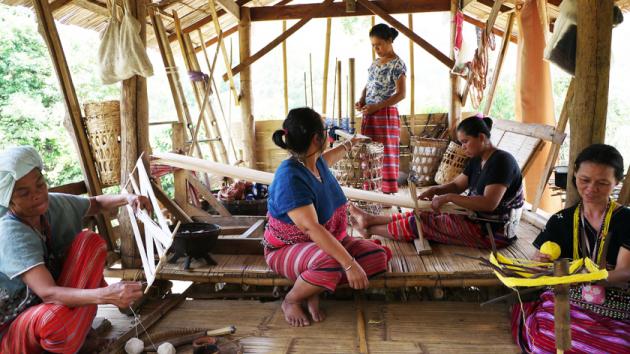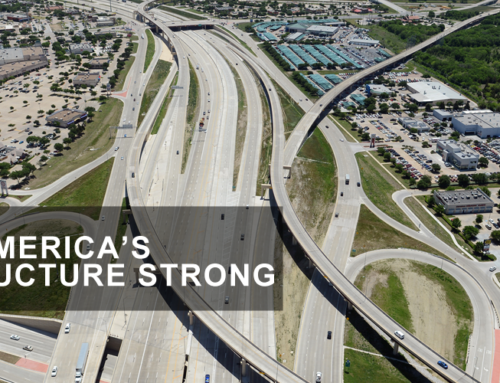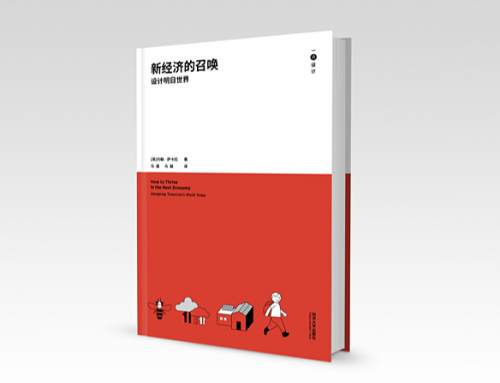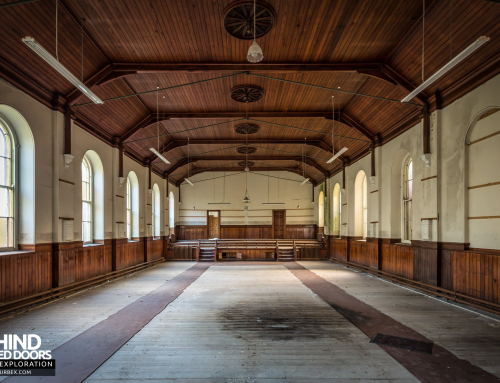The following is an edited version of my keynote talk, delivered by video to the Craft Reveals conference at the Chiang Mai Vocational School in December 2016. The conference was hosted (and my talk commissioned) by the British Council Thailand.
Around the world, a new economy is being shaped by a “leave things better” story about the meaning of progress and development. In a million projects, people are growing food, restoring soils and rivers, designing homes, generating energy, journeying, caring for each other, and learning, in new ways.
These activities are incredibly diverse, but a green thread connects them: the regeneration of local living economies. Growth, in this story, takes on a new meaning as the improved health of soils, rivers, plants, animals – and people. Production is re-imagined as a source of equipment for the local system: from greenhouses and water tanks, to solar panels and mesh networks.
At the same time, new tools and business models are transforming relationships between makers and users: Sharing and Peer-to-Peer; Community Ownership; Platform Co-ops; Fair Trade; The Maker Movement; Civic Ecology; Circular Economy; Food and Fibersheds; Transition Towns; Bioregions.
Traditional craft communities, which so often embody healthy relationships between people, place, and living systems, can be important partners for learning and innovation in this new economy. What kinds of relationship, in this context, are most promising?
Maker economies
The rapid emergence of maker spaces, distributed manufacturing, new distribution channels, and disruptive business models, is blurring the distinction between developed and undeveloped, ‘them’ and ‘us’.
Craft producers in the South are just as much actors in a making economy as are the Fab Labs, makerspaces and microfactories that are blooming in the North.
The rediscovery of rust-belt production resources – “tractor factories” as they call them in Bilbao – is further broadening the range of options for local production. In the forgotten industrial zones of many rustbelt cities, hundreds of local factories, workshops and makers are hidden away, and just about hanging on – but still viable.
The MakeWorks ‘factory finding’ platform launched in Scotland (see above) is a great example; their platform is now starting up in Bristol and Birmingham, too. Another great example, Farm Hack (see below) was born in the US but has now been launched in Scotland, too.
Digital platforms are a means to an end in this context. They make it easier for creative professionals to source local fabricators, material suppliers and open-access workshop facilities.
Documenting these resources is a creative activity in itself. It involves extensive research, mapping, filming and photography of factories, makers and manufacturers.
A number of web-based platforms have emerged as an online marketplace for makers — including OpenDesk, Etsy, Shapeways, Ponoko, Quirky, Kickstarter, and The Grommet.
But according to Will Holman, the economics of making things in a makerspace, and selling them through web-based platforms, are as tough for a designer selling on Etsy as its is for an artisan in Thailand. Most makers in the the US online marketplace earn less than the U.S. median wage.
A purely transactional maker economy, based only on selling things, is unlikely to be sustainable in the longer term.
If it’s just about the thing,
someone will soon find a way to source a similar thing,
but cheaper.
Rather than focus only on selling products as the core measure of progress, it makes more sense to focus on the resources and connections needed for a regional economy to thrive.
Foodsheds
In agriculture, the healthiest food systems and landscapes have been created, shaped and maintained by generations of farmers and herders building on local knowledge and experience. Artisan traditions that embody healthy relationships between people, place, and living systems, can therefore be our teachers.
So-called extension services in which farmers—often women— teach other about about agroecological practices are more developed in the south than in the city-dwelling north. In large areas of Asia, farmers are able to join farmer field schools, a group-based learning process that enables farmer-to-farmer instruction.
The opportunity here is to accelerate learning among growers groups whose expertise and resources, when pooled, can deliver a lot of the value currently added by today’s cost-adding layers of intermediaries. Of particular importance are alternative trade networks and the Community Agroecology Network.
Fibersheds
Networked actions at a bioregional scale are also emerging in the form of Fibersheds . The fibershed model integrates all the activities involved in growing, making and using fibre within a soil-friendly, climate-beneficial fibre system.
Fibersheds are organised at the scale of a bioregion. Each region’s shepherds and farmers, producers, shearers, artisans, designers, knitters, fiber entrepreneurs, and clothes-wearing citizens, discuss what practical steps are needed to bring ‘farm-fresh’ clothing to their situation.
As shared production facillties and network coordination improve, small fibersheds are beginning to link together in pan-regional networks to share knowledge and facilities in ways that improve supply.
Poor-To-Poor Energy
Rural, artisan and cash-poor communities in cities are highly innovative, too, in obtaining energy for daily life necessities. We have much to learn from the ways these communities procure, deploy and share affordable, general-purpose, low-tech tools and equipment.
The North can help amplify this capability. Open-source platforms that enable distributed, peer-to-peer energy production, and local area networks, can enable energy and value flows from poor-to-poor. New coop models make it easier for individual energy producers – at a household or community scale – to pool resources to meet local needs.
In Australia, for example, whose west coast residents see 300 days of sunshine per year, citizens trade directly with the people around them rather than sell excess energy back to the power company. In a project inspired by Brooklyn Microgrid, energy meters in each participating household are fitted with Raspberry Pi mini-computers to track their energy usage. Homeowners decide to whom and for how much to sell their excess renewable energy. A blockchain ledger keeps track of transactions.
In the Brooklyn Microgrid (above) homeowners decide to whom and for how much to sell their excess renewable energy. The model has the potential to be adapted in poor-to-poor communities everywhere.
The design tasks here are not just about discrete bits of equipment, such as solar panels, or water pumps. Bottom line: resilience is not primarily about products. An entrepreneur who understands this, Paul Polak, reckons the design and technology of a device, such as a pump, is not much more than ten percent of the complete solution. The other ninety percent involves distribution, training, maintenance and service arrangements, partnership and business models. These, too, have to be co-designed.
Solidarity
The ‘gig economy’ and the ‘precariat’ may be uncomfortable novelties for people in the North – but for eighty percent of the world’s population they are the old normal. As welfare and solidarity innovators, we have much to learn from different times as well as from different places.
For most of human history, people have met daily life needs through networks of reciprocity and gifts. Communities have survived, and often prospered, thanks to social systems based on kinship, sharing, and myriad ways to share commonly-held resources. Work has been done for generations without being packaged as permanent jobs.
(Above: bicycle-based wool seller in India – one of many examples of India’s dynamic economy of informal two-wheeled traders. For more examples see velowala.org )
Many historic practices are being reinvented in megacities across the global south. Informal settlements are filled with pop-up retail, street traders, guerilla gardening, and informal parks. In the world’s refugee camps, too, myriad micro-economies are constantly evolving in which in which people share energy, materials, time, skill, software, space, or food.
What precarious or informal workers most need but usually lack, is the capacity to plan ahead rather than be perpetually at the mercy of fickle seasons, or regulations. Liquidity – money – is always an issue. So, too, is the need for insurance against unforseen events. These needs, too, are beginning to met by next-generation ways to mutualize risk among trusted networks.
Money will not disappear as this new economy unfolds – but it will be only part of the picture., and there will be more than one variety. Trust between people, shared ownership, and networked models of care, depend more on social energy, and trust, than on fixed assets and real estate. There’s an emphasis on collaboration and sharing; on person-to-person interactions; on the adaptation and re-use of materials and buildings.
Bioregions
This mulitude of bottom-up new project seedlings is cheering – but something more is needed if the whole is to be more than the sum of its parts. A compelling story, and a shared purpose, are needed that diverse actors can relate to, and support, whatever their other differences.
A strong candidate for that connective idea is the bioregion. A bioregion re-connects us with living systems, and each other, through the unique places where we live. It acknowledges that we live among watersheds, foodsheds, fibersheds, and food systems – not just in cities, towns, or ‘the countryside’.
Growth, in a bioregion is redefined as improvements to the health and carrying capacity of the land, and the resilience of communities. Its core value is stewardship, not extraction.
Bioregions can be what Noble Laureate Ilya Prigogine described as “small islands of coherence” that, in a sea of chaos, that have the capacity to “shift the entire system to a higher order”.
Cooperation Platforms
Traditional does not mean static. Exciting opportunity for innovation lie in combining the knowledge systems, tools, and cultural assets of South and North into new forms of finance, law, policy, and culture.
Relocalising at the scale of a bioregion does not mean the end of trade and exchange. On the contrary, there are numerous ways to share ideas and tools for food, energy fibre production in loose associations – think Hanseatic League of Bioregions. The geographical rule is that light things – bits, information, shared/open source design may well travel, but heavy things (atoms, the physical, manufacturing) stay local.
Platform cooperatives have been heralded as an alternative to platforms like Uber which exploit and disempower workers. But platform coops have a broader potential, too, as the infrastructure new alliances between cities, citizens and public utilities working together on water supply, waste disposal, and energy provision.
Platform coops cannot be downloaded in a simple click, like an app. A lot of work is needed to foster trust and clarity of purpose among members. But platform coops are not landing on empty ground. Millions of people are already collaborating to meet social needs in new ways. Their energy and creativity can be harnessed, right now, to to accelerate the spread of the platform coop approach.
end











